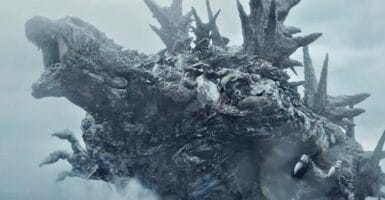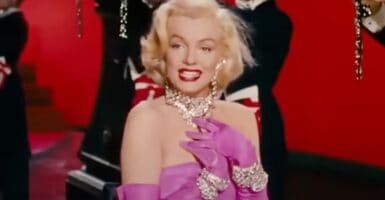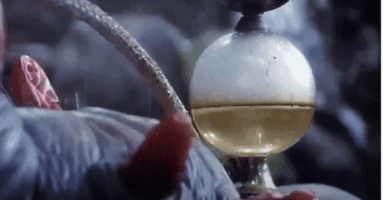Steven Moffat Says Doctor Who Won’t Ignore Peter Capaldi’s Past Roles In The Show
This article is more than 2 years old
 When it was announced that Peter Capaldi would be taking the TARDIS keys from Matt Smith and stepping into the role of the Twelfth Doctor later this year, many pointed out that the actor has already popped up in the Who-niverse. Twice, actually: once in the 2008 episode “The Fires of Pompeii” and again — playing a different character — in the excellent 2009 Torchwood: Children of Earth. There’s nothing terribly unusual about all of that; it’s hardly the first time an actor has put in minor appearances in Who before moving on to a more substantial role. But recent comments from showrunner Steven Moffat suggest that Capaldi’s role as the Doctor not only won’t ignore his earlier appearances, but they may serve as an actual plot point within the show.
When it was announced that Peter Capaldi would be taking the TARDIS keys from Matt Smith and stepping into the role of the Twelfth Doctor later this year, many pointed out that the actor has already popped up in the Who-niverse. Twice, actually: once in the 2008 episode “The Fires of Pompeii” and again — playing a different character — in the excellent 2009 Torchwood: Children of Earth. There’s nothing terribly unusual about all of that; it’s hardly the first time an actor has put in minor appearances in Who before moving on to a more substantial role. But recent comments from showrunner Steven Moffat suggest that Capaldi’s role as the Doctor not only won’t ignore his earlier appearances, but they may serve as an actual plot point within the show.
So what the hell does that mean? Let’s take a look at Moffat’s exact words. In a video interview with Nerd3 (seen below), Moffat addresses Capaldi’s earlier roles in Who and Torchwood by saying:
I remember Russell [T Davies] told me that he had a big old plan as to why there were two Peter Capaldi’s in the Who universe: one in Pompeii and one in Torchwood. When I cast Peter and Russell got in touch to say how pleased he was, I said, ‘Okay, what was your theory and does it still work?” and he said, ‘Yes it does. Here it is…’
We’ll play that one out over time. It’s actually quite neat.
Curiouser and curiouser. As we said, this is hardly a unique situation. Over the years, actors such as Karen Gillan, Freema Agyeman, and Eve Myles, to name but a few, all put in small appearances in Who or Torchwood before returning in a bigger role and a major way. Gillain played a soothsayer in — oddly enough — the same Pompeii episode as Capaldi; Agyeman appeared in 2006’s “Army of Ghosts” before becoming companion Martha Jones beginning in the following year’s “Smith and Jones”; and Eve Myles appeared in the very first modern season’s “The Unquiet Dead” before returning as one of the main characters of the Torchwood spinoff — playing a character theorized to be the descendant of her previous character. Hell, even Sixth Doctor Colin Baker put in an earlier appearance, in the Fifth Doctor’s “Arc of Infinity” adventure, before being cast as the next incarnation of the show’s iconic protagonist.
Both Russell T Davies and Stephen Moffat have played with the series’ long history and mythology in interesting ways over the years, so the notion that somehow Capaldi’s multiple appearances will actually tie into his new version of the Doctor is intriguing indeed. After all, the upcoming 50th anniversary special is already throwing a huge twist into the works with the notion of John Hurt playing a secret or forgotten regeneration of the Doctor. It’s especially interesting that the twist was thought of by previous showrunner Davies. Moffat has very much put his stamp on the show over the past few seasons, so the idea of the two creative leads putting their heads together for something big is exciting.
But how exactly could this notion of the next Doctor somehow being tied to Capaldi’s other roles actually play out? Unsurprisingly, Moffat isn’t telling, but he does offer up some tantalizing clues. In the same interview, he says:
The face is not set from birth. It’s not like he was always going to be one day Peter Capaldi. We know that’s the case because in “The War Games” [the final serial featuring Patrick Troughton’s Second Doctor] he has a choice of faces. So we know it’s not set, so where does he get those faces from? They can’t just be randomly generated because they’ve got lines. They’ve aged. When he turns into Peter he’ll actually have lines on his face. So where did that face come from?
So, is he suggesting that the Doctor’s physical appearance over the years — at least after he initially regenerated from the First Doctor into the Second — is actually based on other characters throughout the time stream, rather than simply randomly generating a new look? If so, what are the implications of that? The Doctor pretty clearly isn’t making the selections himself, as he’s always surprised and it’s a tradition now for the new guy to have a funny little scene where he figures out his new face. Either way, this could make for some fun exploration of Who mythology, or it could just wind up being dumb. I’ll keep my fingers crossed for the former.
Doctor Who: The Day of the Doctor will premiere on November 23rd.












